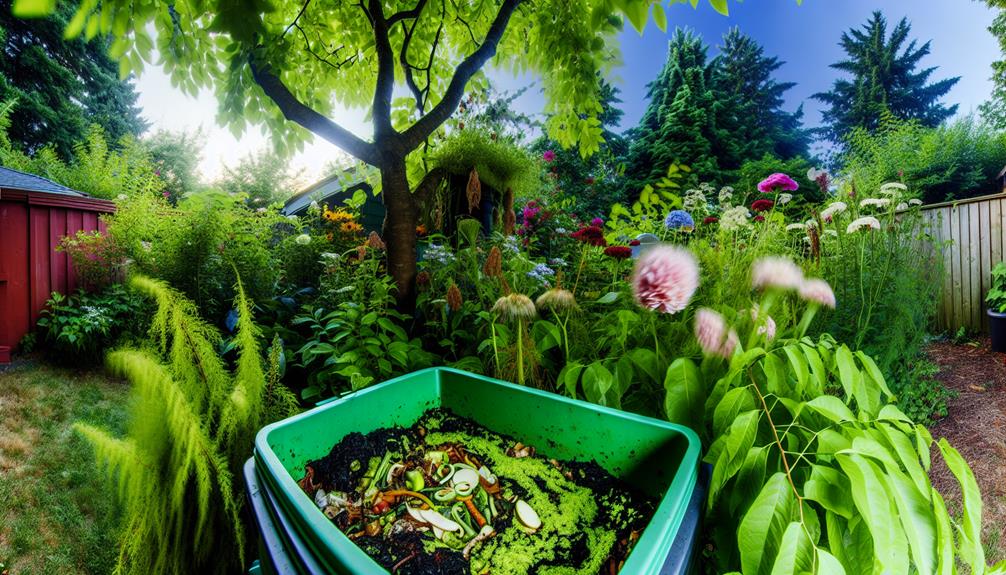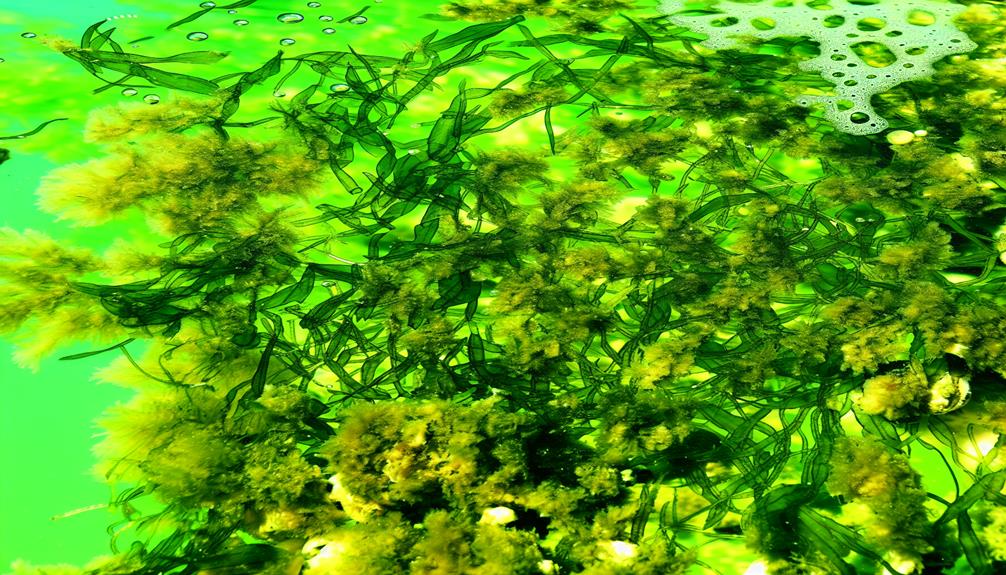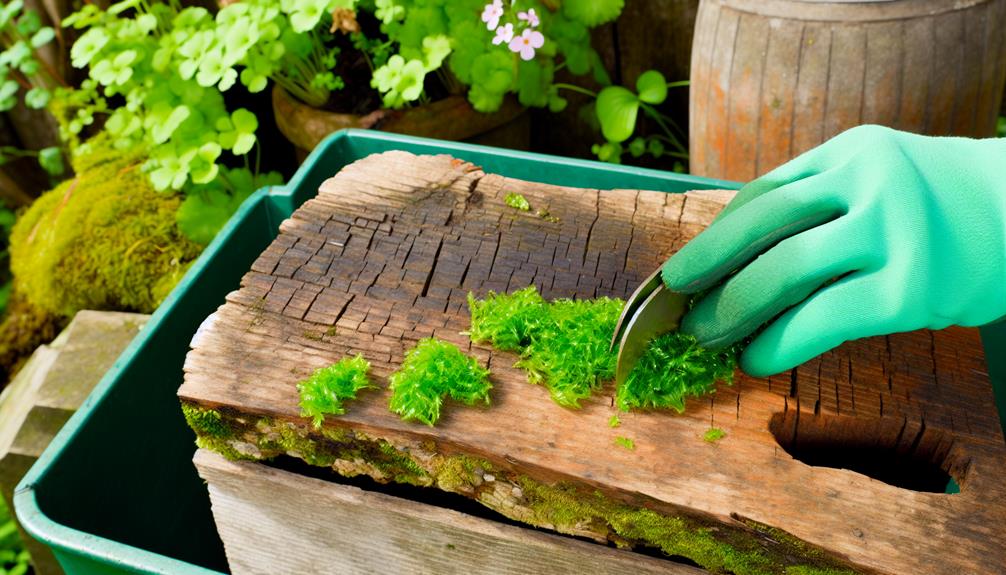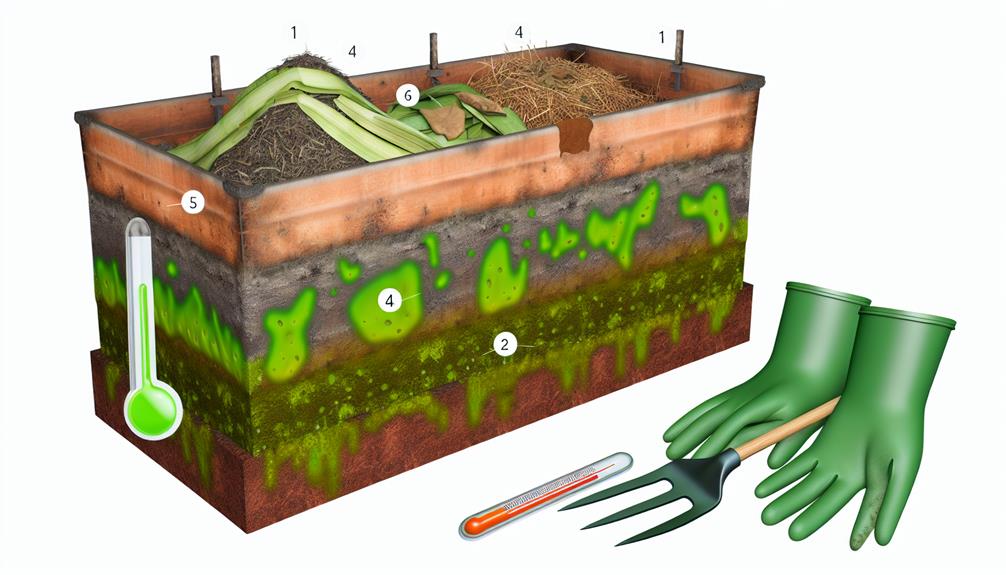

Yes, you can compost green algae. It’s rich in essential nutrients like nitrogen, potassium, and phosphorus, making it a great addition to your compost pile. To start, collect algae from water bodies using protective gear and rinse it thoroughly to remove contaminants. Dry it out and then layer it with carbon-rich materials in your compost.
This balance promotes efficient decomposition and enriches your soil. Regularly turn the compost pile to guarantee proper aeration and moisture levels. If you manage your compost correctly, green algae can greatly enhance soil health and reduce waste. For more detailed guidance, keep exploring.
Composting green algae offers numerous environmental and agricultural benefits. By incorporating green algae into your compost, you’re contributing to a reduction in greenhouse gases. This practice diverts organic waste from landfills, greatly lowering methane emissions—a potent greenhouse gas. You’re also supporting the environment by recycling nutrients back into the soil, which promotes healthier plant growth.
When you compost green algae, you’re not just helping the planet; you’re also saving money. Traditional fertilizers can be expensive, but by creating your compost, you reduce or even eliminate that cost. This cost savings can be substantial over time, especially if you’re managing a large garden or farm.
Additionally, green algae is readily available in many aquatic environments, meaning you don’t have to spend extra money sourcing compost materials. Collecting algae from local water bodies can be a community activity, enhancing your sense of belonging and shared purpose.
To maximize the benefits, mix the green algae with other compost materials like kitchen scraps and yard waste. This helps balance the carbon-to-nitrogen ratio, ensuring efficient decomposition. By following these steps, you can positively impact the environment and your wallet.
Also Read: Can You Compost Celery?
Green algae are packed with essential nutrients that can greatly enhance your compost’s quality.
When you add green algae to your compost, you’re not just recycling waste; you’re enriching the soil with valuable minerals and vitamins.
This enhancement helps improve soil structure, promotes plant growth, and guarantees a healthier garden.
Packed with essential nutrients, green algae can greatly enhance the nutrient profile of your compost. By adding green algae to your compost pile, you’re introducing a nutrient-dense material that originates from marine ecosystems. This nutrient density means your compost will be rich in minerals and elements that plants thrive on, such as nitrogen, potassium, and phosphorus.
Since green algae are loaded with micronutrients and trace elements, your compost will become a powerhouse of growth potential. When you incorporate it, you’re not just adding another organic material; you’re blending a unique substance that markedly boosts the overall nutrient content. These nutrients will break down and become more accessible to the plants that will eventually benefit from your compost.
To effectively use green algae in your compost, gather algae from local lakes or ponds, making sure it’s free from pollutants. Rinse it thoroughly to remove any excess salt if you’re collecting from a saltwater source. Mix it well with other compost materials like kitchen scraps and yard waste. This balance ensures the algae decomposes efficiently, enhancing your compost’s overall quality.
By incorporating green algae into your compost, you greatly enhance the soil quality, enriching it with essential nutrients and organic matter. This practice improves soil aeration and moisture retention, making your garden thrive. Green algae is packed with nitrogen, potassium, and phosphorus, all vital for healthy plant growth. Your plants will benefit from these nutrients, leading to vibrant blooms and robust vegetables.
Consider this: green algae can break down quickly, integrating seamlessly into your compost pile. This rapid decomposition means it’s an important addition, speeding up the composting process and yielding rich, dark compost faster. Not only does it improve soil structure, but it also fosters a beneficial microbial environment.
Here’s a quick comparison of how green algae improves soil quality:
| Benefit | Impact on Soil |
|---|---|
| Nutrient Enrichment | Provides essential N, P, K |
| Soil Aeration | Enhances root growth and oxygen flow |
| Moisture Retention | Helps soil retain water, reducing drought stress |
| Microbial Activity | Promotes beneficial microorganisms |
Also Read: Can You Compost Basil?
When choosing green algae for composting, you should consider species like Cladophora, Spirogyra, and Ulva for their nutrient richness. These types of green algae are excellent sources of nitrogen and other essential nutrients that can enhance your compost.

Cladophora is a freshwater species commonly found in rivers and lakes. Its high nutrient content makes it an excellent addition to your compost pile.
Spirogyra, another freshwater species, is easily recognizable by its filamentous structure and vibrant green color. Incorporating Spirogyra into your compost can help improve its overall nutrient profile.
On the other hand, Ulva, also known as sea lettuce, is a saltwater variety. This type of green algae thrives in marine environments and is packed with minerals like iodine and potassium. Adding Ulva to your compost can provide a broader range of nutrients, making your compost even more beneficial for your garden.
When collecting green algae, always wear protective gear like gloves and goggles to safeguard against potential irritants.
Choose early morning or late afternoon for collection, as these times often have lower temperatures and reduced sun exposure.
This guarantees you stay safe while gathering algae efficiently.
To collect green algae safely, you’ll need to wear essential protective gear that includes gloves, goggles, and a mask. Safety gloves protect your hands from irritants and potential contaminants in the algae. Choose gloves that are waterproof and durable, making sure they won’t tear or become ineffective during collection.
Face masks are important for protecting your respiratory system. Algae can release spores or other microscopic particles that may be harmful when inhaled. A good-quality mask will help filter out these particles and keep you safe. Opt for masks that snugly fit your face and have high filtration efficiency.
Goggles shield your eyes from splashes and debris. Given that algae often thrive in water, there’s a risk of waterborne contaminants. Proper eye protection will prevent irritation or infection. Make sure the goggles fit well and don’t fog up easily, providing clear vision while you work.
Lastly, wear clothing that covers your skin to avoid direct contact with algae, which might cause irritation. Long sleeves, pants, and closed-toe shoes are advisable.
This ensemble of safety gear ensures you can collect green algae efficiently and safely, fostering a sense of community and shared responsibility for environmental stewardship.
After gearing up with the necessary protective equipment, it’s important to know the best times to collect green algae for composting. Timing your collection can make a significant difference in the quality and safety of the algae.
First, consider the seasonal availability of green algae. You’ll find it most abundant during warm months, especially in late spring and summer. During this period, algae thrive due to increased sunlight and warmer water temperatures.
Next, focus on the best times of day. Early morning or late afternoon are ideal for harvesting. The sun isn’t too harsh, reducing the risk of overexposure and ensuring the algae is fresher.
Finally, pay attention to local water conditions. After heavy rainfalls, the water might be clearer and the algae more accessible.
Here are some key tips to remember:
Also Read: Can You Compost Barbecue Sauce?
Start by thoroughly rinsing the green algae to remove any salt, debris, or contaminants. This step is essential to make sure that the algae won’t introduce unwanted elements into your compost pile.

After rinsing, you’ll want to initiate the drying process. Spread the algae out on a clean surface under the sun. This helps reduce moisture content, making it less likely to create a soggy compost pile. Alternatively, you can use a drying rack or old window screens for even airflow.
Once the algae is dry, you can start incorporating it into your compost pile using a layering technique. Begin by adding a layer of dry algae, and then follow it with layers of other compost materials like dried leaves, kitchen scraps, or grass clippings. This method ensures even decomposition and prevents clumping, which could hinder the composting process.
Keep in mind that algae is high in nitrogen, so it pairs well with carbon-rich materials.
Following these steps not only breaks down the algae effectively but also enriches your compost. By preparing algae correctly, you’ll create a balanced compost pile that benefits your garden and fosters a sense of community among fellow composters.
Balancing your compost pile involves maintaining the right ratio of green algae, rich in nitrogen, to carbon-rich materials like dried leaves and straw. Achieving this balance is essential for efficient decomposition and a healthy compost heap. You’ll need to guarantee both compost aeration and moisture balance to keep the microbial activity thriving.
To help you succeed, consider these tips:
When adding green algae, mix it thoroughly with other materials to avoid compacting. Compaction reduces airflow, which is important for compost aeration. Proper moisture balance promotes microbial activity, accelerating the breakdown process. By monitoring these factors, you’ll create an environment where your compost can thrive.
Joining a community of fellow composters can provide additional support and insights. Share your experiences and learn from others to enhance your composting journey. Together, you can make the most of green algae and other compostable materials.
Also Read: Can You Compost Artichoke?
Inevitably, you’ll encounter some common issues when composting green algae, but don’t worry—most are easily fixable. One frequent problem is improper moisture levels. If your pile is too wet, it can become anaerobic and start to smell. To fix this, turn the pile more frequently and add dry materials like straw or leaves. Conversely, if it’s too dry, sprinkle it with water to achieve a damp sponge-like consistency.

Temperature control is another important factor. A compost pile that’s too cool will decompose slowly. To boost temperature, add more green materials like kitchen scraps or grass clippings. If it’s too hot, which is rare, turn the pile to release excess heat and add brown materials to balance it out.
Here are some quick solutions to common problems:
| Issue | Cause | Solution |
|---|---|---|
| Bad Odor | Too much moisture | Turn pile, add dry materials |
| Slow Decomposition | Low temperature | Add green materials, turn pile |
| Pile Too Dry | Insufficient moisture | Sprinkle with water |
Yes, green algae in your compost can attract pests. For effective pest control, practice good compost maintenance by regularly turning the pile and balancing green and brown materials. You’ll keep your compost healthy and pest-free.
You’ll find green algae’s decomposition rate in compost is relatively fast, usually taking a few weeks. This speedy breakdown helps with nutrient release, enriching your compost and making you feel part of a sustainable gardening community.
Yes, you can compost green algae from a saltwater environment, but be cautious. Saltwater contaminants and marine pollutants might harm your compost. Rinse the algae thoroughly and make sure your compost community remains safe and thriving.
Composting green algae can affect the pH of your compost, potentially causing pH fluctuations. To maintain nutrient balance, regularly monitor your compost’s pH levels and adjust with other materials to guarantee a healthy compost environment.
You’ll find that leafy greens and flowering plants particularly benefit from composted green algae. It boosts nutrient absorption and soil enhancement, creating a thriving garden community you’ll love being a part of.
To sum up, composting green algae is a practical way to enrich your compost pile with valuable nutrients.
Make sure you collect algae safely, rinse it to remove salt, and balance it with brown materials like leaves or straw.
Monitor moisture and aeration levels to prevent issues like odors or pests.
By following these steps, you’ll effectively integrate green algae into your compost, enhancing soil health and promoting sustainable gardening practices.
